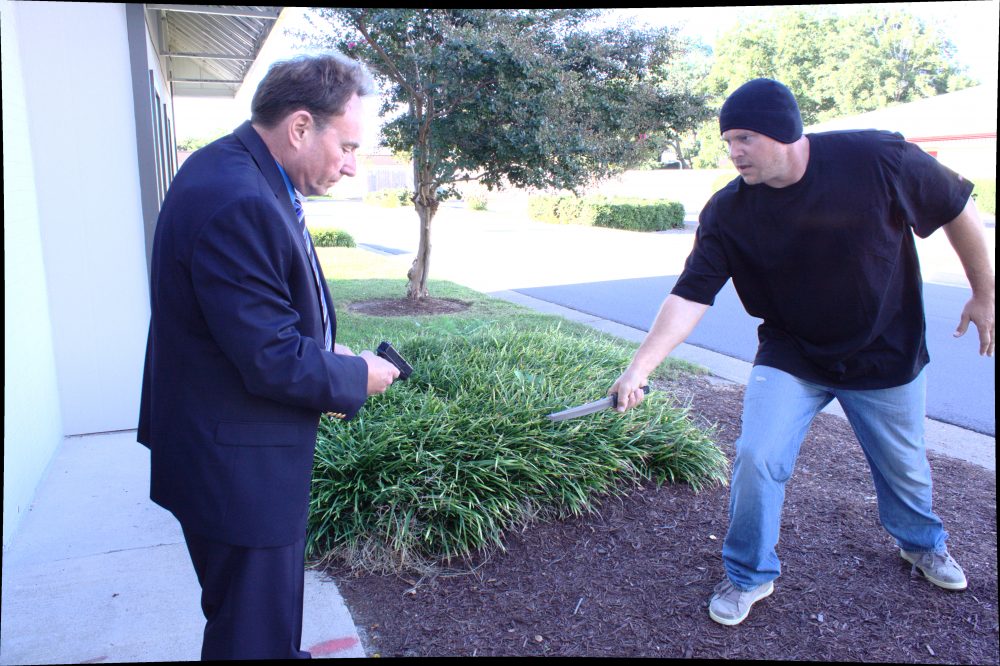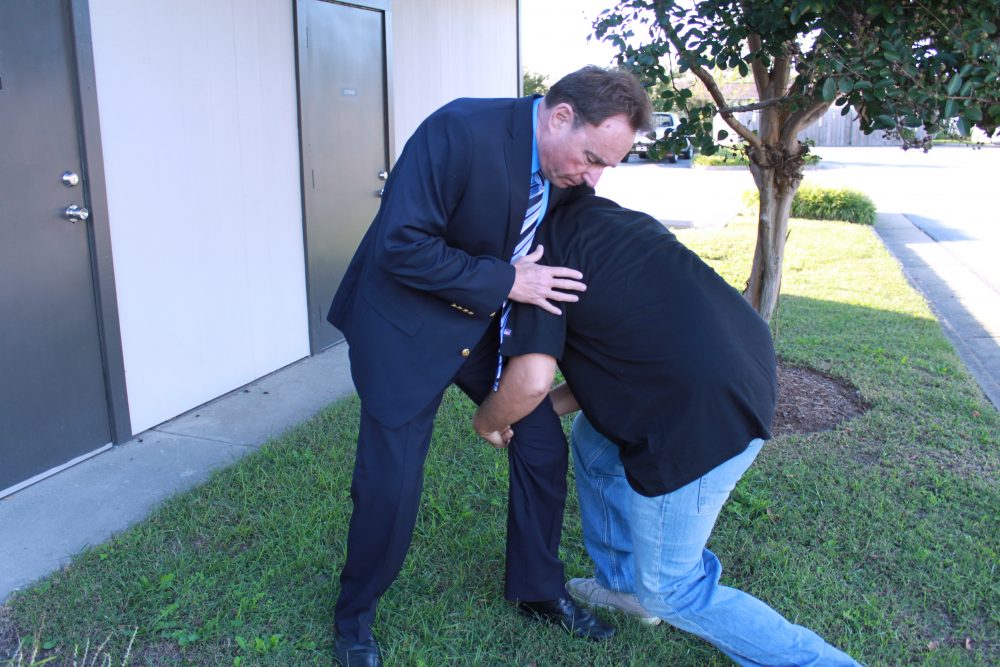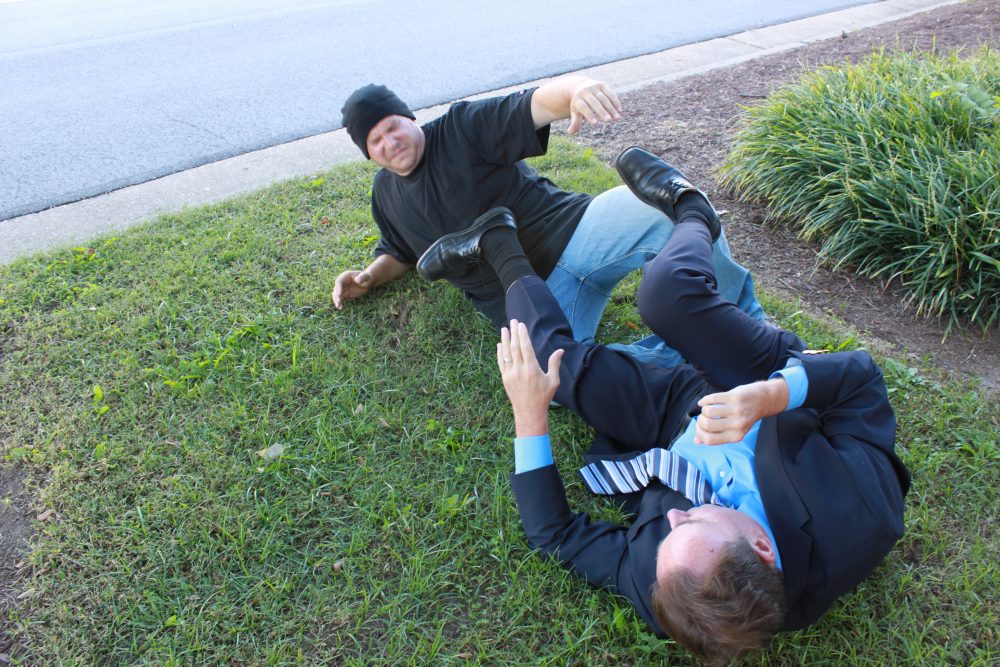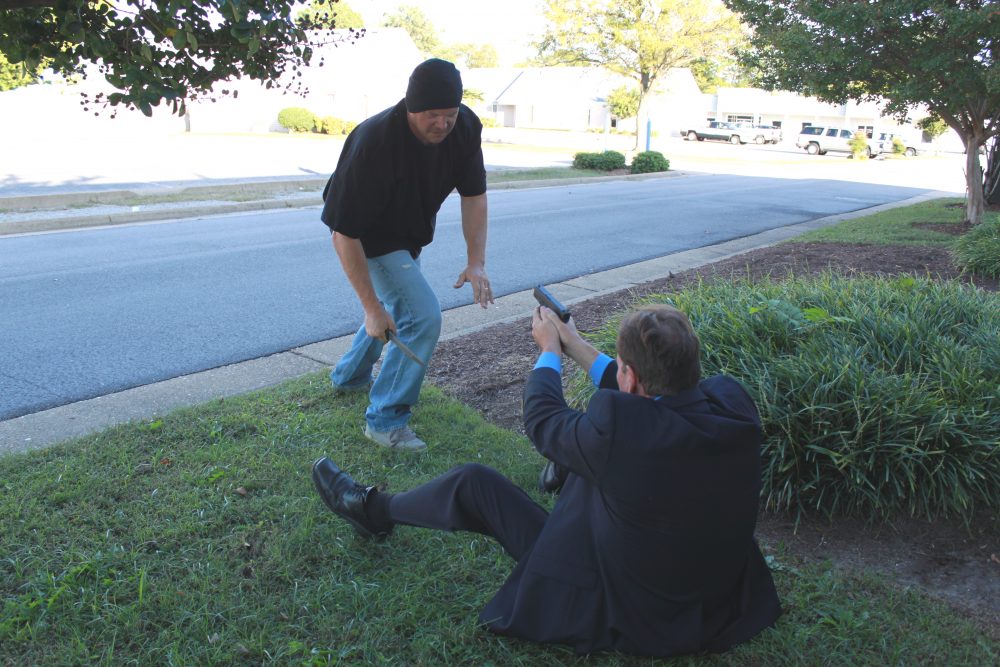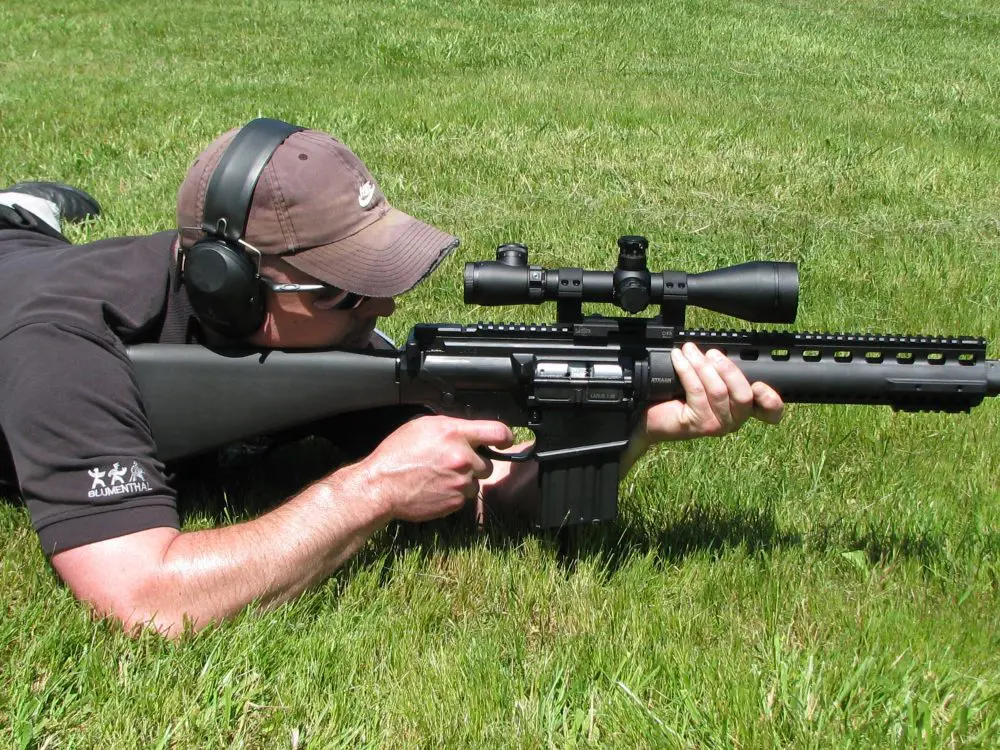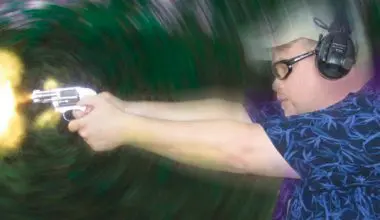More than 25 years ago, then-Sergeant Dennis Tueller of the Salt Lake City Police Department determined that an attacker with a knife could cover 21 feet in approximately 1.5 seconds. Since then there have been many articles written and countless debates regarding what has become known as the Tueller Drill.
The fact remains that the ability to draw your firearm, shoot and stop an attacker wielding a knife or other weapon and coming at you aggressively from 21 feet or less is extremely difficult, if not impossible. The key to this debate is not being able to get a shot off, but stopping the aggressor prior to a serious or fatal blow from a lethal weapon.
From a distance of 21 feet, the detective has 1.5 seconds to respond to an attack from an assailant.
Table of Contents
CLOSE QUARTERS BATTLE
Countless studies have shown that most serious confrontations on the street occur within a distance of ten feet or less. Today, many law enforcement agencies and departments have been focusing on close quarters battle training to address this problem. Simply put, you may not have time to deploy your weapon fast enough in a life and death scenario.
Many CCW permit holders have had extensive training in gun safety, shooting from the Isosceles or Weaver stance at a target, shooting on the move, drawing from concealment, doing quick magazine changes, and clearing malfunctions. Although very proficient at handling a firearm, they may lack the necessary skill sets to deal with a lethal attack at close quarters.
Detective attempts to draw gun and fire while being charged with a knife from 21 feet.
This article will deal with the most difficult situation: Being charged and taken to the ground in a lethal attack situation before you have a chance to draw your firearm. The attacker may be much larger and stronger than you.
And even if you possess a high level of ground fighting skills, you need both hands to protect your sidearm, thus nullifying most of your firearm techniques. The situation is further complicated if you are worried about protecting a loved one as you are taken down to the ground.
Assailant begins to take detective to the ground.
How can you level the playing field against an attacker who is much larger, stronger and more skilled? Know how to cheat. Techniques such as biting and eye gouging can give you the edge and time you need to get the attacker off you to draw your firearm, get to your feet, or run. Think about what happens in a mixed martial arts or boxing match when someone gets poked in the eye or bitten: the referee stops the fight to give the fighter time to recover. There is no referee in a street encounter to allow someone to recover.
When someone is on top of you, throwing a barrage of punches at your face or trying to stab you, drawing a weapon from concealment is not an option. Prior to deploying your firearm, you need to deal with the attack. Trying to remember complicated moves while under extreme stress does not work. Keep it simple and effective.
Detective fights off assailant after being taken to the ground.
INSTANTANEOUS ASYMMETRICAL VIOLENCE
The cutting-edge key to this dilemma is a principle called instantaneous asymmetrical violence: attacking the eyes and groin and evoking a little-known and extremely lethal martial art called Kino Mutai (the Filipino art of biting and eye gouging). This is the quickest way to get your attacker off you and give you the appropriate distance to draw your firearm and get to your feet.
This asymmetrical combat is much more ubiquitous than the average pedestrian would ever know. It has been taught to the highest levels of specialized government agencies and spec war ops, including, but not limited to, the Department of Defense and U.S. Navy SEALs DEV Group (SEAL Team 6). One can become fairly proficient at this in a short amount of training time.
Detective uses art of Kino Mutai against assailant by gouging assailant’s eye with his thumb while still controlling the head.
The best technique to use against a lethal ground attack is a hybrid of Brazilian Jiu-Jitsu and the aforementioned Kino Mutai. After countless years of training, I have found that when a stronger, skilled opponent attempts to tackle you to the ground, it’s better to flow with the tackle rather than fight it. In some cases, it may happen so fast you might find yourself on the ground with an opponent on top of you.
As the attacker wraps his arms around you, simply lie back and wrap your legs around his waist. This tried and true position used in Brazilian Jiu-Jitsu is called the guard and has been employed for the last 20 years in the UFC—the ultimate proving ground.
Assailant attempts to pull back after Kino Mutai eye gouge and bite. Detective creates space by using his legs to kick assailant off.
From this guard position, wrap your arms around the opponent’s neck in what looks like a simple choke and, with your top thumb, evoke the deadly art of Kino Mutai and simultaneously gouge the attacker’s eyeball. Continue to hold on tight and gouge the eye to make him want to get off you. A light poke and quick release will just annoy him.
His visceral reaction 999 out of 1,000 times is to fly off you as if he were grabbing a hot stove and then hold on to the injured eyeball, screaming in agony (he’s not thinking of you going for your sidearm in light of this intense pain). This gives you time to kick him off and draw your weapon from a seated position or get back to your feet.
Detective takes advantage of space created when kicking assailant off, draws his weapon, and fires.
IN CLOSING
This guard and eye gouge move is just one example of instantaneous asymmetrical violence. After thousands of hours of hands-on training over decades, the only techniques I can guarantee will neutralize an aggressor under such extreme conditions are asymmetrical techniques: attacking the eyes, groin, and a specialized form of biting.
Key training points are: hardwire these moves slowly hundreds of times before going full speed, and make sure your training partner wears protective goggles to avoid injury.
[Editor’s Note: It is impossible to become proficient at any self-defense technique by reading about it. Just as with firearms training, it is incumbent upon the individual to seek out reputable instructors and then continue to hone their skill sets. Dedicated practice and training go a long way toward creating the desired outcome in the real world.]
Paul Vunak is president of Progressive Fighting Systems, headquartered in Mission Viejo, California. Paul has more than 30 years’ experience training military, law enforcement and civilians, including the U.S. Navy SEALs DEV Group, DoD, DEA and FBI.
SOURCE
Progressive Fighting Systems
(757) 724-6653
www.fighting.net


